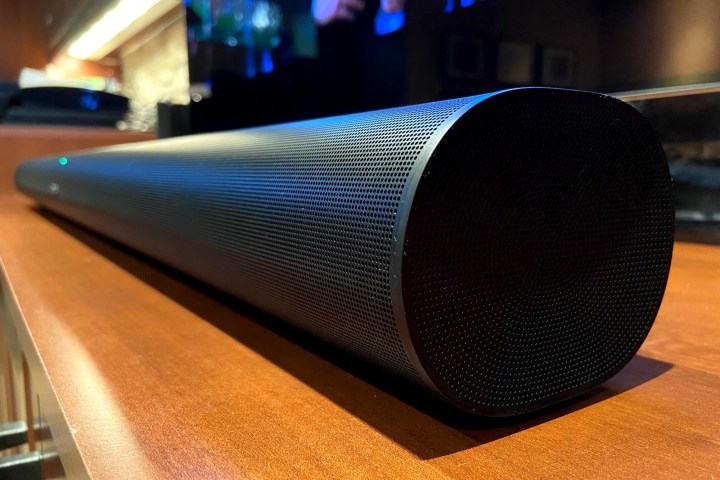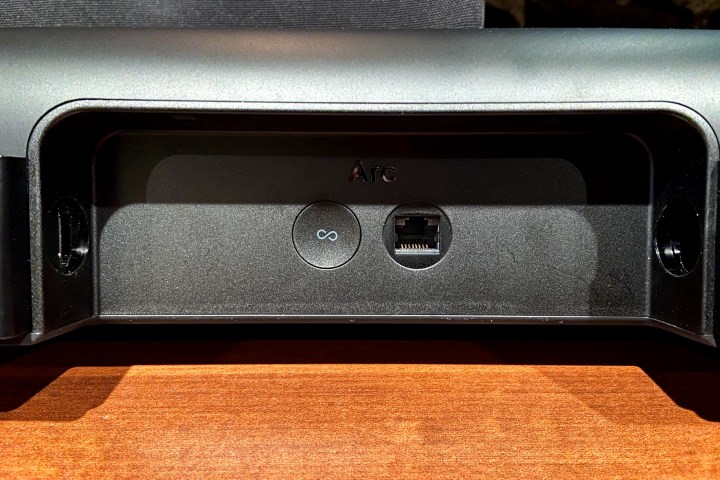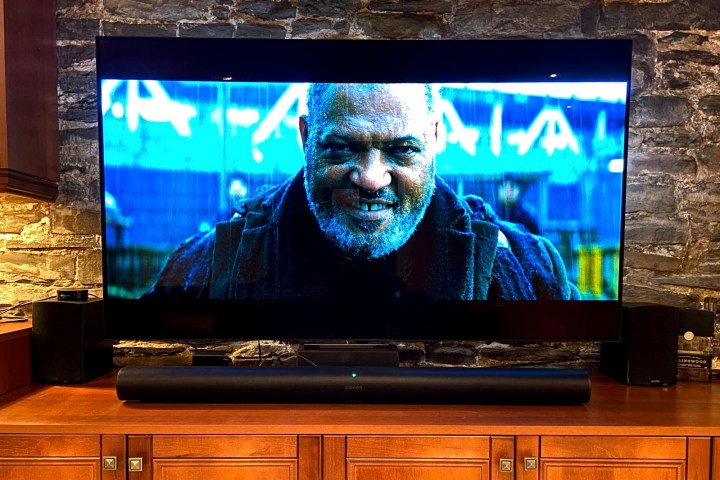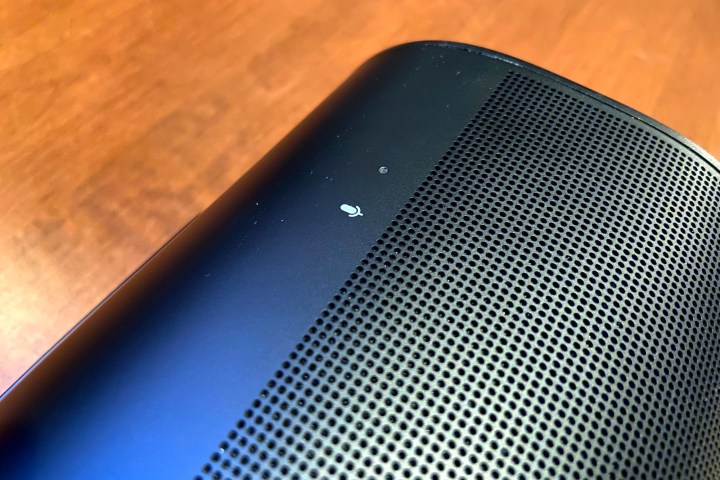- Excellent surround sound
- Easy and simple setup
- Decent Dolby Atmos from a single speaker
- Choice of Alexa or Google Assistant
- No HDMI inputs
- Not ideal for all music genres
When Sonos debuted its first soundbar, the $699 Playbar in 2013, it received well-deserved praise. As a dead-simple, but somewhat pricey way to give your TV a massive audio upgrade, it succeeded on just about all but one front: The decision on Sonos’ part to equip the Playbar with a single optical input meant the Playbar would forever be locked out of the expanding world of surround formats like Dolby Digital Plus, Dolby TrueHD, and Dolby Atmos — something reviewers noted at the time as a drawback to an otherwise superb product.
Seven years later, Sonos has returned to the full-size home theater soundbar arena with the $799 Arc, a Dolby Atmos-capable speaker that shows off everything the company has learned since the Playbar’s debut. Did Sonos push the envelope far enough this time, or has it simply played catchup? Let’s take a look.
Gorgeous design

I’ve said before that when it comes to soundbars, the best designs draw no attention to themselves at all. After all, your visual focus should be on your TV, not your soundbar.
Whether your primary aesthetic is low-key Darth Vader or low-key Stormtrooper, there’s a Sonos Arc to suit your tastes
But just because a soundbar shouldn’t compete with what’s on-screen, that doesn’t mean it needs to be a boring slab of plastic. In classic Sonos fashion, the Arc manages to exude a subtle elegance when it’s not acting as your TV’s partner and then disappears almost entirely when it’s time to dim the lights and start the show.
I credit this chameleon-like performance to our review unit’s matte black finish. It worked for me — though, for the first time, Sonos also has a full-size soundbar you can also buy in matte white. Whether your primary aesthetic is low-key Darth Vader or low-key Stormtrooper, there’s a Sonos Arc to suit your tastes.
The design of the single-piece wrap-around speaker grille comprised of hundreds of tiny holes gives the Arc the same understated monolithic look as the company’s other recent products, such as the Move, Sonos One, One SL, and the updated Sonos Five.
Sonos has placed the Arc’s touch controls on the top of the soundbar, which feels like a more logical position than the Playbar’s more awkward side controls. However, this placement means that sliding the Arc fully underneath your TV will make these controls difficult or impossible to get to. That might not matter though as, with all Sonos products, you can control the speaker entirely from your phone, tablet, or computer.
Just like with the Playbar, you can sit the Arc in front of your TV, where you’ll need at least 2.5 inches of clearance if you want it to sit directly under the screen. It can also be wall-mounted, but be prepared for some sticker shock: The optional steel bracket is a whopping $80 — a full 10% of the price of the Arc itself.
Limited connectivity

Sonos prides itself on its commitment to simplicity and the Arc embodies that fully with its extremely easy set-up: A single HDMI ARC/eARC port on the rear of the speaker is all you need to connect it to your TV. Just plug one end of the included HDMI cable into that port, plug the other end into your TV’s HDMI ARC/eARC port, plug the power cable in, and you’re essentially good to go.
The rest of the setup process happens in the Sonos app. It only takes a few minutes and includes Sonos’ Trueplay tuning feature. Trueplay is how Sonos gains an understanding of your room’s acoustics. It can then optimize the Arc’s EQ for better music and presumably, better Dolby Atmos. Trouble is, Trueplay is an iOS-only feature that requires the microphone on an iPhone, iPod Touch, or iPad. Android users are out of luck.
Sonos points out that you can always borrow an iOS device to Trueplay your system, but that seems like cold comfort for those who have chosen to stay out of Apple’s well-manicured but walled garden.
Sonos prides itself on its commitment to simplicity and the Arc couldn’t be simpler to set up and use.
Ironically, Sonos’ desire to keep things simple has created a degree of inconvenience, too. HDMI ARC/eARC is a terrific concept because it lets you send digital audio and video to your TV while simultaneously letting your TV send digital audio back to your soundbar or AV receiver. But the Sonos Arc hogs that connection for itself, turning it into an audio-out port only.
That’s because the Arc, unlike a lot of soundbars on the market, doesn’t have an HDMI input. All of your source devices, such as game consoles, cable boxes, streaming media devices, or Blu-ray players must connect directly to one of your TV’s other HDMI inputs, which creates three potential problems.
First, unless your source device is a stick-style gadget like a Fire TV Stick, you will need to run one HDMI cable per device to your TV — in addition to the HDMI cable the Arc requires. Depending on your home theater installation, that could be tricky.
Second, few TVs ship with more than four HDMI inputs. Once you’ve connected the Arc, you’re down to three. If three inputs aren’t enough, you’re going to need an HDMI switcher to convert one of those three into two or more additional ports.
If you can get by with just three ports (or if your TV happens to have more than four to start with) and you don’t mind running a few more HDMI cables, then don’t give this another thought. If, on the other hand, you were hoping to replace a six- or seven-input AV receiver with the Arc, you’ll need to do some homework before placing your order.
Third, because the Arc can only receive audio via your TV, the audio it receives will be dependent on what your TV supports. Not all TVs support Dolby Atmos, for instance, so if you connect an Apple TV 4K to a TV that isn’t capable of passing along Doby Atmos over HDMI ARC, the Sonos Arc will likely end up getting regular Dolby Digital 5.1. Without a direct HDMI input, the Arc remains forever at the mercy of its TV counterpart.
I should note that if your TV doesn’t have HDMI ARC at all, you can use the included optical-to-HDMI adapter, but you won’t be able to receive Dolby Digital Plus or Dolby TrueHD, and thus, no Dolby Atmos. Dolby Digital 5.1 will still sound amazing, but it doesn’t take advantage of the Arc’s full range.
When Sonos released the Arc, it wasn’t compatible with LPCM multi-channel sound — a problem for those with devices that rely on this format, like the Nintendo Switch. But as of November 2020, Sonos has released a firmware update that turns on LPCM support.
Sensational surround sound

Just like every other speaker Sonos makes, the Arc manages to deliver a bigger and richer sound than its compact housing suggests. Bass — the key ingredient for home theater sound — is remarkably thunderous for a soundbar. The uninitiated will look around the room in search of the subwoofer that simply isn’t there.
Equally impressive is the Arc’s ability to reproduce dialogue. It’s clear and precise, even without engaging the optional dialog-enhancement mode. That’s a testament to Sonos’ understanding of what makes watching TV enjoyable. You can have the most immersive multichannel sound system on the planet, but if you can’t understand what the actors are saying because of muddy dialogue, your viewing experience will be significantly damaged.
Bass — the key ingredient for home theater sound — is remarkably thunderous for a soundbar.
Thanks to its upward-firing height channel drivers and its phased speaker array, the Arc also creates an expansive soundstage, making it an ideal single-speaker solution for way better TV audio.
Most people will end up using the Arc with Dolby Audio in either 2-channel stereo or 5.1 audio because these two formats represent the majority of available streaming and broadcast content. The Arc does a great job with both, easily filling even larger rooms with expansive, thrilling sound.
Entry-level Dolby Atmos

That same stellar audio experience is true for the Arc’s headline feature, Dolby Atmos, but you will need to temper your expectations a little. The Arc uses a pair of upward-firing speakers to reflect the “height” portion of a Dolby Atmos soundtrack back to your viewing position. It’s the same technique used by all Atmos-capable soundbars and even some dedicated Atmos speakers.
The effectiveness will be very dependent on the geometry of your room. In my basement TV room, with 7.5-foot ceilings, I was definitely aware of the increased sense of 3D space, but it was a subtle effect rather than something that grabs you by the lapels. There’s no visual indicator on the Arc that lets you know you’re listening to Dolby Atmos, but a quick glance at the app will provide confirmation if you’re not sure.
I tested the Arc’s Atmos chops with recent action-oriented favorites like Ford v Ferrari, Avengers: Endgame, and John Wick Chapter 3: Parabellum. Whether it’s roaring race cars, thundering spaceships, or ricocheting bullets, the Arc can help put you front and center for all of the action.
If you find that the Arc’s height channel reproduction feels weak, perhaps because of the shape or angle of your ceiling or your distance to the soundbar, you can adjust the volume level of the upward-firing drivers. This ability was added via a software update that Sonos released on May 12, 2021. I haven’t had a chance to test this new setting, so your mileage may vary.
At the moment, the Arc only supports Dolby Atmos, not DTS:X, which offers a similarly immersive experience to Atmos but is not as well-supported by Blu-rays or streaming services. If DTS:X support matters to you, check out the excellent Vizio Elevate soundbar, which supports both Dolby Atmos and DTS:X.
Adding a sub and surrounds
I think the Sonos Arc is terrific on its own, but if what you seek is an even bigger and better sound, you can have it. Sonos lets you expand the Arc’s capabilities by adding a $699 Sonos Sub, and you can use any matched pair of Sonos speakers as your surround satellites — even a pair of $99 Ikea Symfonisk Bookshelf speakers.
I recommend both upgrades. The Sub will take the Arc’s impressive bass from good to gargantuan (and it’s the only subwoofer that is compatible with the Arc), while a pair of surrounds will help the Arc fill in some of those sounds that it can’t quite reproduce by bouncing audio toward you. I tried it with a set of Sonos One SLs — which was amazing — but I believe any pair of Sonos speakers would give the Arc a helpful boost.
Music performance

Soundbars are first and foremost about delivering better TV audio, but the Arc isn’t just a soundbar. As a full Sonos speaker, you get all of the benefits of the Sonos system: A brilliant mobile app that gives you total control over your music sources, your speakers, and indeed, your whole home should you wish to expand into multi-room audio.
If you need your soundbar to perform double duty as your primary source of music, the Arc can do it. The only caveat here is that because the Arc is tuned to deliver optimal results for TV audio, it doesn’t possess the same sound signature as other kinds of speakers, or even other Sonos speakers. The same emphasis on higher frequencies and lower frequencies that make for such compelling movie magic, don’t always mesh well with all music genres.
Vocal-forward tracks by Adele, for instance, are definitely enhanced. Billie Eilish’s Bond theme, No Time To Die is another example of a track that benefits from the Arc’s theater-inspired acoustics. But jazz standards, classical compositions, and even some straight-up pop and rock songs can feel a bit trapped by a lack of definition through the midranges.
Atmos Music
However, there is a caveat to my caveat: Dolby Atmos Music. As luck would have it, Tidal added the ability to stream Dolby Atmos Music from its Apple TV 4K app the same week I was wrapping up my time with the Sonos Arc.
Dolby Atmos Music on the Arc is a joy. Tracks that have been mastered in Atmos Music (or remastered in it) can, depending on the song, give you an entirely new appreciation of the music. A fabulous example is The Doors’ classic Riders On The Storm. The rain and thunder that have always felt underwhelming to me when listening in stereo, suddenly become an intimate and essential part of the music. Jim Morrison’s already haunting lyrics and vocals get a shiver-inducing ghostly echo after lines like “There’s a killer on the road.”
I don’t know if those elements have always been a part of the song or not, but with the combination of Atmos Music and the Arc, you can’t ignore them. Not every Atmos Music track is equally mesmerizing, but if you can afford the $20 per month Tidal HiFi subscription tier, and you have a compatible streaming device, I highly recommend it.
AirPlay 2 and voice assistants

The Sonos Arc doesn’t have Bluetooth — a feature that almost every other soundbar has — so you won’t be able to connect to it directly from your phone. Instead, you can use Apple’s AirPlay 2 technology to connect from your Apple device over Wi-Fi. As much as this may frustrate Android users, in practice, there’s only one situation where it will be an issue: Playing music that only lives on your Android device.
The Arc also benefits from Sonos’ agnostic approach to voice assistants. You can choose to use either Amazon Alexa or Google Assistant, though only one at a time. The Sonos Arc and Beam used to be the only smart soundbars to provide this choice, but Bose now offers a similar choice for its Smart Soundbars.
I had some trouble getting Google Assistant set up, but I’ll chalk that up to the beta software I was using. Alexa worked flawlessly.
Having a voice assistant in a soundbar is actually a pretty big deal. Beyond the obvious benefits of a smart speaker (playing music, controlling smart home devices, and getting answers to your questions), because the Arc is connected to your TV via HDMI, you can use a variety of voice commands to turn the TV on and off or adjust the volume. Your specific TV may support even more commands depending on the model and whether it’s compatible with Google Assistant or Alexa.
Our take
The $799 Sonos Arc is the home theater upgrade that Sonos fans have been waiting for. It delivers superb surround sound, a good if subtle Dolby Atmos experience, plus all of the benefits of a smart speaker and Sonos’ unique multiroom audio system. Only its lack of HDMI inputs and slightly compromised music quality keep it from being a perfect soundbar for the price.
Is there a better alternative?
If what you want is an Atmos-capable soundbar with a choice of voice assistants and the ultimate flexibility of Sonos’ multiroom audio system, there simply isn’t a second option at any price.
If you love the idea of a Sonos Dolby Atmos soundbar but would prefer not to have a microphone in your living room, the Costco-only Sonos Arc SL delivers that option, for $50 less than the regular Arc.
If you’re willing to forgo Dolby Atmos, the Bose Soundbar 700 is the same price and does a better job with music reproduction (though it can’t do Atmos Music). You get the same choice of voice assistants, and the ability to add wireless accessories like subwoofers and surround speakers, but the Bose app doesn’t offer anywhere near the multiroom audio control or the superb universal search of the Sonos app.
If you’re willing to get into multiple speaker units, you can get a more convincing Dolby Atmos experience. Our top picks from this category are:
- Vizio’s $700 5.1.4 system
- The $1,000 Vizio Elevate
- Or, for even more punch, you can pick up the LG SN11RG for $1,700
All three have multiple HDMI inputs, too.
How long will it last?
Despite the fact that Sonos recently ended support for some older devices, you can expect the Arc to last for years, if not decades. Sonos products are well-built, and the Arc is no exception.
Should you buy it?
Yes. For Sonos users, the Sonos Arc is an absolute no-brainer. It’s just $100 more than the Playbar it replaces, yet it offers better sound, Dolby Atmos, AirPlay 2, voice assistants, and more. As long as you’re OK with having to use your TV’s HDMI inputs or an HDMI switcher to connect your video sources, the Arc will reward you with terrific home theater audio for under $1,000.





